Shaky Worm Fishing
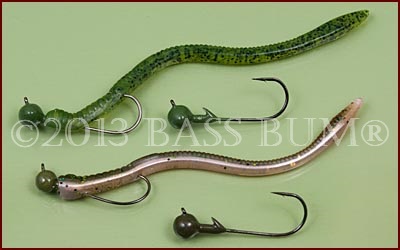
The Cure For The Common Case Of Bass Lockjaw
Shaky worm fishing is a bit like drop-shotting. It's not intended as a "search" or "power" technique but rather one of finesse to be used when the location of bass is known, but for whatever reason they will not bite. It's a "focused, precise" presentation which is aimed at and kept in a specific location. It's mostly characterized as lead-head jigs combined with short plastic fishing worms that are "shaken" gently to create an image of a bottom feeding creature. This little rig is called a shaky head rig.
Shaky Worm Fishing - When And Where?
Thought of as a clear water technique and probably most effective there, many have success in stained water as well.
Best times of the year to fish it? Well, I find it effective virtually year round to differing degrees. However, it is reasonable to identify post-spawn, after summer cold fronts and during winter when bass tend to go hold along bluffs as some of the better times for the shaky-worm. The one exception is pre-spawn as the bass are in an aggressive state of mind and many other non-finesse lures work well.
Shaky worm fishing is recognized as a very good technique for use around boat docks, rock ledges, gravel points, standing timber and other forms of wood cover. The one place to avoid? Thick grass.

Shaky Worm Technique
Simple for sure. Cast to your target area. Let your lure sink to the bottom. Make sure you do this on "slack" line so the lure sinks straight down to the target and does not swing back toward you away from where you feel the bass are located.
Once on the bottom, while holding your hod tip at about the 10:00 position, maintain a bow in your line from your rod tip to the water's surface. An important aspect of shaky worm fishing is fishing it on slack line. Why? Because imparting a subtle shake to a slack line causes the worm's tail to move but does not move the entire rig from its spot on the bottom. You want to move your line, not your lure. Shake, then pause, then shake again. Don't hop it along, scoot it.
By the way. There is nothing negative about shaking the rig as it drops. In fact, strikes do occur on shaky head rigs on the drop, though most happen after they hit bottom.
Now I'm not saying you leave your lure in one spot shaking it incessantly till your wrist hurts. That you never move it. Strikes often occur within seconds after "touchdown" on the bottom. If not, you then begin to shake it. After a short period, and you decide what is short. Slowly drag the rig across the bottom till to another spot and begin shaking again.
The Art of Shaking
The force used for "shaking" your rig is subtle. The best motion is one that utilizes moving just the forearm an inch or two while keeping the wrist stiff. Basically, you're taking up the loop slack when you move your forearm up and releasing it again when you move your forearm downward. No wrist flexing or total arm action necessary. This would move your lure too far from the target or lift it off the bottom. It's the same forearm, elbow posture used when you lift a beer to your mouth. You know what I mean now don't you?
Now everybody has his/her own way of doing this. The goal is to leave the lure shaking on the bottom in one place till you're ready to move it. Not before. You shake the line which subtly gives motion to the the jig and worm in place. You should not actually be moving the lure across the bottom!

Shaky Worm Gear
Rod
A good rod for shaky worm fishing is a spinning rod 6'6" to 7' in length. A rod that has a very forgiving tip that is easy on light line, remember 6-8lb test is the norm, but a strong butt to enable sweeping hook-sets should be sought. In fact, most companies make rods that are technique specific for shaky-worm fishing. G. Loomis has an excellent shaky head rod series. They're fast at the tip but have plenty of backbone as well. I most often use a G. Loomis SHR822S which is 6'10" in length with a Mag M power and XF action tip. If you're not into such specialty rods any medium action rod with a soft tip and good backbone will suffice.
Reel
A reel with a large arbor is best since the shaky worm fishing technique is one which calls for fluorocarbon line. Remember, it's primarily a clear water technique, and since it's worked slowly the bass have a chance to get a good look at it and any line attached to it.
We all know how aggravating fluorocarbon line can be on a spinning reel. So, a large arbor reel will cause less "loop memory" in the fluorocarbon line and thus fewer bird's nests. Fluorocarbon is also more sensitive and it sinks, which helps take a lightweight shaky head worm down.
Line
Fluorocarbon is the shaky-worm rig line of choice. As for weight, 6-8lb test is preferred. Remember, it's a bit tougher than monofilament of the same weight but it still can not be used to "horse" a bass into the boat.
If you're not comfortable with loading your spool 100% with fluorocarbon, reel on 10-12lb monofilament on the first two-thirds of the spool leaving only the last third of the reel's capacity for fluorocarbon. Join the two lines with a blood knot.
Best Worms For Shaky-Worm Fishing?
There are many from which to choose. I use some from Strike King, which are "buoyant" and "very durable", both outstanding traits for a shaky rig. I also like the Zoom trick and finesse worms in 4", 5" and 7" lengths. The Berkley 5" and 7" Powerbait worms are also very good, at least in my experience. Netbait also has a nice series of 5" finesse worms that work well on a shaky rig.
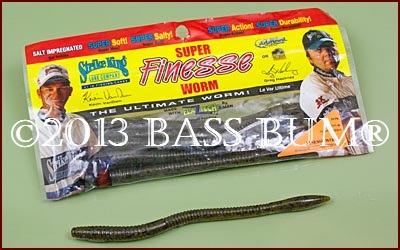
These worms from Strike King are great worms. As I said, they're durable and buoyant. But I must tell you, and maybe it's just me, but they're a pain in the backside to get on any jighead I've ever used "except" Strike King's.
The stretchy nature of the worm, which is what makes it so tough and long lasting, literally fights you when you're trying to position it over the lure keeper whether it's a tooth or spring. The springs are especially problematic as they will just about not penetrate the material.
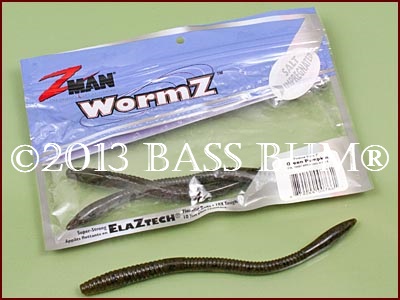
The same thing applies to ZMan worms. The material is great. Very buoyant, so it stands upright. Almost indestructible too so are a real value for the money.
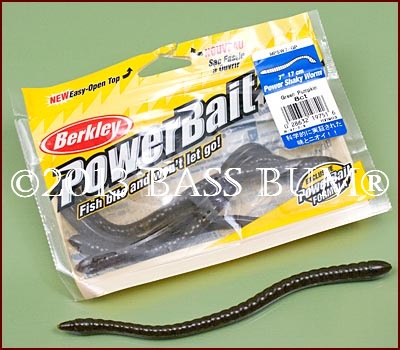
Berkley products are hard to beat for shaky worm fishing or just about any other bass fishing technique. I do feel there is something to their claim that fish bite and hold on a little bit longer, due of course, to a "secret formula" in which their baits are soaked.
With a jig of any type this is important for bass can spit out a lure that "doesn't feel or taste right" faster than you can blink your eyes. Bass are particularly adept at spitting out jigs as they are heavy and hard, uncharacteristic of baitfish and even crawfish.
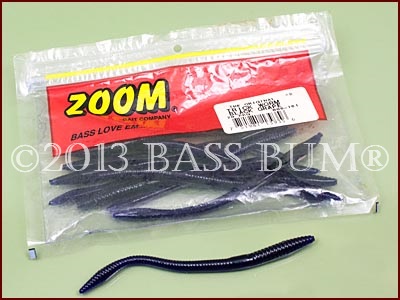
ZOOM has an excellent line of plastic baits. Their 4" finesse worm and venerable "Trick Worm' are always in my bag and are well suited for shaky worm fishing.
Placing The Shaky Worm On The Jighead
There are two ways to rig the shaky worm on the hook. The first is basically Texas rigging
it. That is, with the hook point not all the way through the worm but
just under the skin, below left. The other is to push the point completely through
the worm so it is exposed, below right. This is
better when shaky worm fishing in open water situations. Some anglers
feel the exposed hook gives a better hook-set.
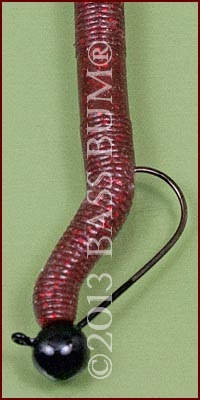 |
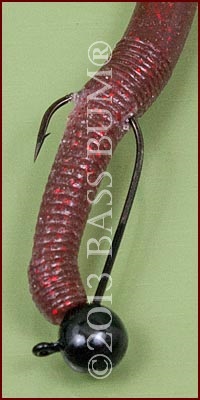 |
And Color?
As usual, when shaky worm fishing, as with other techniques, dark stained water calls for brighter colors and clear water for more natural colors.
The Shaky Jighead Itself Is All Important. What Should You Look For When Selecting One?
Return To Bass Fishing Techniques From Shaky Worm Fishing
